Vagabonding in Asia 2009, part 11 of 11: Laos, Cambodia. Bangkok
|
Part 1 China, southeast |
Part 2 China, southwest |
Part 3 China, north |
Part 4 Tibet |
Part 5 Nepal |
Part 6 India, south |
|
Part 7 Malaysia |
Part 8 Sumatra and Java |
Part 9 Bali and Lombok |
Part 10 Australia |
Part 11 Laos, Cambodia, Bangkok |
Tour dates: 27 September - 6 December 2009.
Air travel is shown in blue; bus and train travel is shown in pink.
The starting point was Hong Kong.
I have visited almost all countries in southeast Asia, but not Laos, until now. Luang Prabang is Laos' cultural center. As much as I liked Australia, it's good to be back in Asia, away from the perfectly organized affluence and "caution, slippery when wet" signs. Luang Prabang is rather touristy, I saw as many Western tourists as locals on the streets and there are guesthouses everywhere. But it's also peaceful and quiet, with old low houses, narrow streets, very little traffic, no modern buildings, and only a handful of souvenir shops. Small temples are scattered throughout the old town, and Buddhist monks in their orange robes are out on the streets.
Luang Prabang is built along the shores of the mighty Mekong river, which slowly flows down the length of Laos until it emerges in a huge delta in southern Vietnam, where I had gone out in a boat for a few days last year. Long narrow wooden boats are loaded by boatmen carrying huge bags on their shoulders, walking up narrow planks to their boats while tourists watch from restaurant terraces that overlook the Mekong.
Friday, 20 November 2009
Luang Prabang's small old town has a large number of Buddhist temples, all of which are active with many orange-robed monks about. Most are small, but Wat Xieng Thong is an impressive large complex with not only the usual large hall that houses the Buddha shrine, but also a smaller hall with a huge golden hearse for kings, and numerous smaller shrines and living quarters for the monks. Their orange laundry hangs out to dry between the shrines. The walls, inside and out, are covered with gold, gold painting, and glittering glass mosaics.
Took a tour bus to Kuang Si, a park with a large waterfall that drops from a tall hill, and then through a series of wide cascades between turquoise pools. Very beautiful. There are lots of trails in the forest, and viewpoints to watch the falls. There was an annoying loud American on the bus that kept dropping names of all the unexciting places he's been to in Asia and his boring adventures there. He has seen people on the roof of his overcrowded bus, yawn.

| 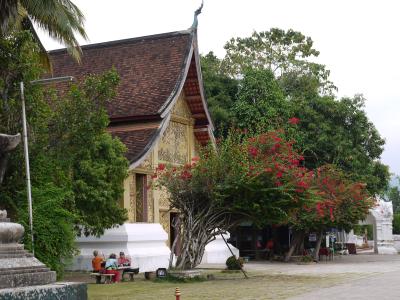
|
| Luang Prabang's night food market | Xieng Thong temple in Luang Prabang |
Luang Prabang is very pretty and avoids all the mistakes that have turned so many other Asian cities into swirling maelstroms of honking traffic and faceless office towers, but it sold its soul to tourism. One hears a lot more German than Lao in the streets, and it's packed with guesthouses, tour operators, and fancy restaurants. It's difficult to find Lao food, it's just an afterthought tacked on to the end of the pizza, burger, and spaghetti sections of the menus (under "Lao cousins" in one place I was eating at). Tomorrow I'll escape to a place without Internet, phones, cell towers, and (most of the day) electricity.
It takes three hours by minibus to the village of Nong Khiaw northeast of Luang Prabang, and another hour in one of the narrow, long Laotian boats up the Nam Ou river, to reach Muang Ngoi. The river is winding its way through densely forested mountains with steep rock faces.
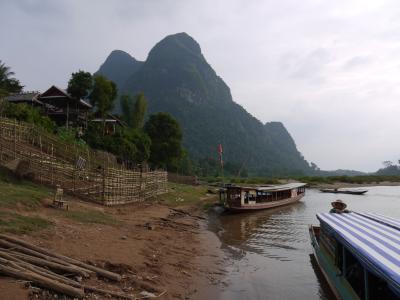
| 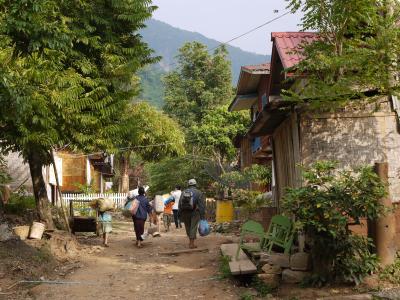
|
| Muang Ngoi village | |
Muang Ngoi is a small peaceful village that consists of a single dirt road lined with small houses built from bamboo and wood, with just a few brick buildings. A long stairway leads up there from the boat landing, where many of the narrow boats are moored. I was staying at the Phetdavanh guest house; it, too, has a wooden frame and bamboo mat walls. There is a nice upstairs terrace with hammocks. It's very quiet in the village - there are almost no phones, no Internet, and my guest house is one of the few houses with electricity. Most others run a generator for a couple of hours in the evening, so the village is very dark.
Sunday, 22 November 2009
In the morning I was woken by roosters. I was planning to stay only one night in Muang Ngoi, but I decided to enjoy the quiet village life one more day before returning to the cities. Late in the morning I went with a few others up the river to Sopjam, a native village that is just a cluster of bamboo houses on wooden stilts. Palm trees and a backdrop of green mountains create a very pleasant atmosphere. They make those narrow Laotian scarves here that are sold in Luang Prabang's night market. Very colorful. The village is full of playing children; families here have four or five children.
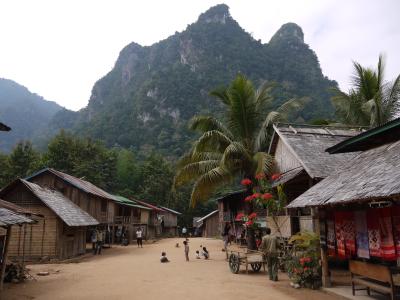
| 
|
| Sopjam village | |
We visited a cave, but since the guide brought only a weak flashlight and a little candle, there wasn't much to see. The real attraction was the narrow path from the river bank through the dense forest up to the mouth of the cave anyway.
We stopped three times to catch fish with a net. The result was one small fish, and a handful of smaller ones. We built a fire on the beach and grilled them. That must have been the freshest fish I ever had, and it tasted great, but it was far too little.
Early in the morning, the monks from the temple went through the village chanting and collecting alms. Returned to Luang Prabang by boat, minibus, and songthaew. The minibus managed to run out of gas 250m before the gas station. This time I didn't bother to reserve a room in Luang Prabang, I just went to a cluster of guesthouses and picked a nice one.
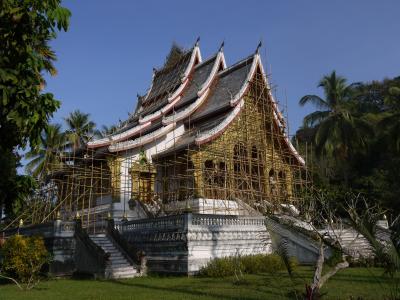
| 
|
| Luang Prabang museum | Mekong riverside bar |
Luang Prabang's National Museum, and former royal residence, is forgettable. It's modern and quite bare and sterile except for the boxy reception room with red walls with gold trim and mirror mosaics. The royal apartment is almost depressing, by place at home is fancier than that. This king must have come down in the world.
The minibus took six hours to Vang Vieng, a small town at the foot of the northern mountains. The bus was packed but I snagged the front seat. We went over two passes at 1000 and 1400 meters with views above the clouds. The mountain scenery is beautiful - craggy karst peaks all around us, forests, lots of banana trees, and small bamboo villages full of children.
Vang Vieng is an unassuming town with few tourist sights that stretches along the Nam Song river. The big thing here is rafting and tubing on the river. Sadly, an alien invasion force has crash-landed in the center and is building big concrete hotels with no consideration or respect for the old town. All around them, nearly identical restaurants with pseudo-western food are springing up. I rented a nice quiet bungalow at the edge of town, but soon the cancer will spread to the whole town and it will be just like Luang Prabang, except ugly. LP, at least, is pretty.
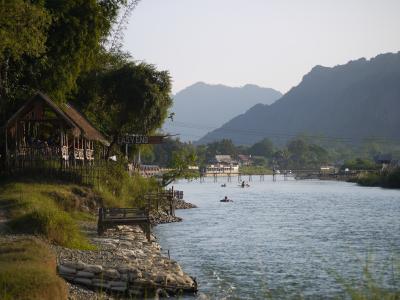
| 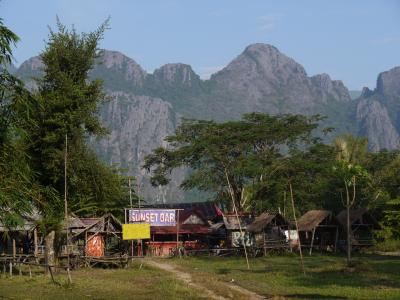
|
| Riverside bars in Vang Vieng | |
Several swaying bamboo bridges cross the river to Dom Khang island, which is still green and quiet, with just a few bars and huts overlooking the river and the dramatic mountain background. I had real Lao food for the first time: pizza. It's difficult to ruin a pizza recipe but the restaurant was totally up to the task. At the next table, a group of girls were ordering, quote, a jug of vodka, end quote. At least the menu didn't list happy pizza or happy drinks, where the "happy" indicates marijuana, meth, or cocaine. I wonder whether the monks at the temple here are sometimes treated to happy alms. (Of course not, monks are revered here.)
Vientiane, Laos' capital, runs along the Mekong river. The height of the river varies, and large sections of Vientiane's riverfront get flooded seasonally. A dam, freshly reinforced with sandbags, protects the city; children play soccer at the shore. The Mekong also divides Laos from Thailand. Late in the afternoon, I watched the sun set over the Thai side of the river.
Vientiane is not as pretty as Luang Prabang and not as peaceful as Vang Vieng, but it's a real live city that hasn't signed over its body and soul to tourism. The pizza parlors are there if you look for them, but the people who live and work here have other concerns and the tourists get lost in the crowds. Vientiane is quiet enough to be pleasant, yet alive and humming like an Asian city and capital should be.
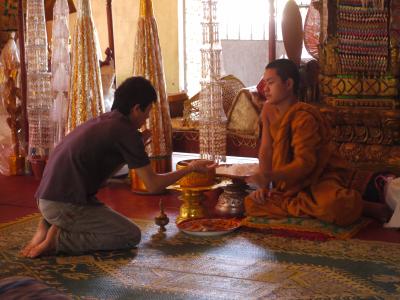
| 
|
| Monk | Victory Gate in Vientiane |
Patuxay, the victory gate, is said to resemble the Arc de Triomphe in Paris but doesn't, at all. It looks imposing from a distance. But from a closer distance, it appears even less impressive, like a monster of concrete. The preceding sentence is a verbatim quote from a large sign mounted on the gate. Honesty is a virtue... Inside, the gate is packed with souvenir vendors.
Vientiane used to be a French colonial capital, and French language is visible everywhere. And they have good honest Laotian food. I'll stay here a little.
Thursday, 26 November 2009
Wat Si Saket is Vientiane's oldest temple. Arcades along the outer walls of the compound have hundreds of sitting buddha statues, and thousands of little ones in niches in the wall. The walls of the central wat with the buddha shrine are covered with murals, but they are crumbling and chipping, and in some places the bricks are exposed and in others repairs were done rather inexpertly. The temple is very peaceful and in a state of picturesque decay.
More than half of Talat Sao, Vientiane's morning market, is already gone, they are building an eight-story mall in its place. What's left is mostly clothes, electronics, and pirated CDs and DVDs. It appears that if you want to sell an mp3 player these days, you must ape Apple's logos and design, but never mind the quality. Talat Khua Din is Talat Sao's slummy little brother, complete with narrow dirt paths, shredded tarps, corrugated metal roofs, and a covered meat market with buzzing flies.

| 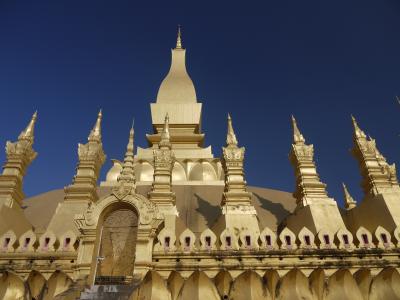
|
| Si Saket in Vientiane | Pha That Luang |
The National Museum has a few pots and tools, but otherwise mostly photos. If I get the gist of it right, it's about the courageous heroic patriotic comrades of the glorious victorious revolutionary Lao Liberation Army, which won the war against the fascist reactionary aggressive US imperialists and their puppets, traitors, savage murderous henchmen, and mercenaries, and Laos has been a communist paradise ever since. It's especially relentless on US imperialists and puppets. To be fair, the US brought enormous destruction and suffering to Laos - unexploded US bombs kill people even today - and the US did lose that war like every other war they ever started.
I went to numerous other temples, but the one that stood out was Pha That Luang (picture), a huge golden shrine with many spires. It's a symbol of Laos and reproduced on the 2000 kip note. I talked to a smiling young monk holding a parasol and a Lao/English dictionary.
The regular bus to Pakse in southern Laos would have taken 18 hours, and the VIP bus runs at night only, so I figured I might as well fly. In Pakse I connected to a songthaew (a brightly colored flatbed truck with benches and a roof) to Champasak, which promptly left after waiting for an hour to fill up. At Champasak, we had to cross the Mekong using a ferry (really just a wooden raft bolted onto a pair of canoes), after another hour of waiting. Every thing here moves slowly and it's a welcome change after Vientiane. Met a guy with a chicken on his lap, and a cynical bitter Australian who has been traveling for 30 years.
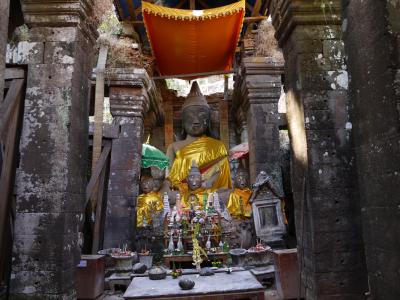
| 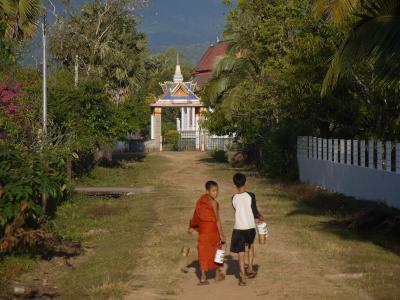
|
| Wat Phu at Champasak | Champasak village |
Champasak is a sleepy one-road village along the Mekong. Most of the guesthouses and restaurants have terraces built on stilts on the bank of the river. People come here to see Wat Phu, a Khmer temple eight km towards the mountains. It's built on three levels connected by steep broken stone steps. The architecture is very similar to Angkor, and it's about as old, but far smaller and in worse shape. Most windows are bricked up, and the walls are crumbling, roofs have fallen, and scaffolds hold up leaning walls and columns. Yet there still is a buddha shrine. It feels like a Tombraider set after the final showdown. Impressive, in a country ravaged by wars where few buildings are older than a hundred years.
A tuk tuk brought me back to the ferry landing in the morning, and I crossed to the other side of the Mekong in a long-tail boat. Long-tail boats are long narrow wooden boats with a sunroof, and an exposed car motor that drives a propeller at the end of a long drive shaft, which is lowered into the water and generates a lot of spray. Took a crowded bus to Hat Xai Khun, which is just a cluster of bamboo houses an hour down the Mekong. Another long-tail boat brought me to Muang Khong, an even tinier and even sleepier village on the island of Don Khong.
Don Khong is a member of Si Phan Don, the Four Thousand Islands in the middle of the river. In the rainy season, the Mekong expands to a width of 14 km here. There are not really 4000 islands here, but there are a few hundred. Don Khong is the largest and one of the few that are inhabited.
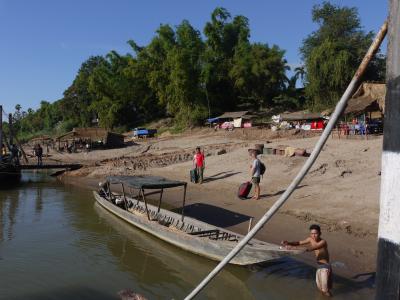
| 
|
| Boat to Don Khong | House on Don Khong |
Muang Khong consists mostly of a single road along the river; the village extends for a few hundred meters. The riverbank is quite steep, and most of the few guesthouses have restaurant terraces on stilts overlooking the river. There is very little to do here other than read and walk. The island gets very rural very quickly outside the village; all houses there (and most in the village) are on stilts and made from wooden planks and bamboo. There are lots of animals. I tried to rent a bicycle but the only one with working brakes had a loose saddle, which promptly broke off when they tried to tighten it.
My guesthouse runs a ferry down the Mekong river. It takes 90 minutes to reach Don Det, another inhabited island of Si Phan Don. many fishermen are squatting on the tails of their little boats, casting their nets. Despite its width, the river flows quite quickly.
The village of Don Det is supremely laid back, strung out along a lone dirt path along the river bank. At the ferry landing, where the boats just run up to the beach, there are a number of guesthouses and restaurants; further down the path are small wooden and bamboo houses on stilts where families live and work in the space under their houses. There are a few backpackers, but everything is extremely quiet.
I wanted a peaceful place in Laos' countryside, and that's exactly what I got. My guesthouse is at the northern tip of the island, and my balcony with a hammock is built on stilts over the river bank. As I write this I am watching the sunset over the Mekong. There is no electricity in Don Det, and hence no hot showers, on the island; some places run a generator for a few hours in the evening. The place does look ready to party, but there were none when I was there.
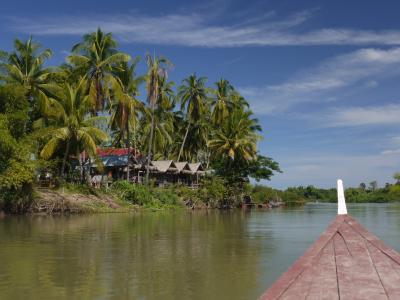
| 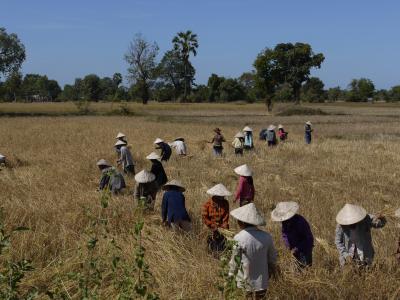
|
| Water taxi to Don Det | Women tending fields on Don Det |
I walked to other end of the island through fields being harvested by old women, until I reached an old bridge from French colonial times that leads to the next island south, Don Khon (not to be confused with Don Khong). There is a small village on the other side, even quieter than Don Det. I got the impression that it attracts a much older crowd of tourists. I did check out the Sala Phaet hotel, which consists of some droopy neglected-looking huts on rafts in the river, for ten times the price of other guesthouses.
Monday, 30 November 2009
Rented one of those impractical bicycles and rode south to Don Khon island, across the French bridge. They built the bridge for the only railway ever operating in Laos; the remains of one engine are still rusting away at the bridge. Rode a narrow footpath through a wat and bamboo, palm, and banyan forests to Tat Somphamit, aka the Li Phi falls. They are not very high, the highest cascades less than ten meters, but a tremendous volume of Mekong water is crashing down at high speed with a loud roar through a rocky canyon. Besides two large falls, there are numerous smaller ones that keep the water light green and covered with white foam for a long way.
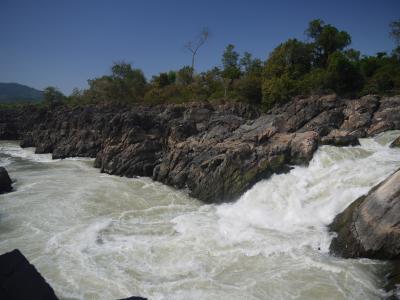
| 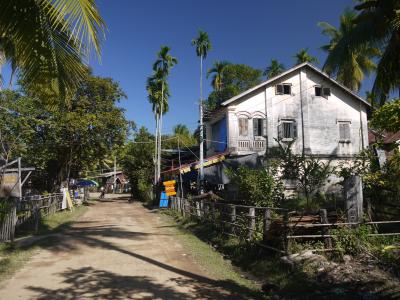
|
| Li Phi falls on Don Khon | Village on Don Khon |
Next I went all the way to the southern end of Don Khon, where I found a small beach jutting out between the main flow of the Mekong and a rapidly flowing side channel that has washed out a quiet pool. Went swimming for a while. It's impossible to swim against the current - even long-tail boats slow to a crawl - but approaching sideways from the pool and grabbing a root while the water rushes past is fun. Although I have traveled on the Mekong before, I have never swum in it before. Southern Laos is hot and sunny but not humid, and the water is quite warm. Not bad for the last day of November.
Yesterday, when swimming, I could see Cambodia on the other side of the Mekong, so I decided to swing by Angkor on my way to Bangkok. A boat brought me to Ban Nakasang, and to a 14-hour bus to Siem Reap in Cambodia. The bus passed within 1km of Vietnam, and within 70km of Phnom Penh, but I resisted these temptations; I have been to both places before. We crossed the Mekong one last time before Kampung Cham and switched to a "private car", which turned out to be a Honda packed with six people, driving in total darkness for three hours on a road with animals, unlit bicycles and overloaded motorcycles, parked trucks, and people sitting in the middle of the street chatting. That last one got a rise out of our otherwise imperturbable driver, "suicidal" he said.
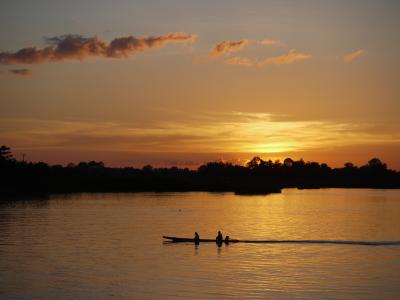
| 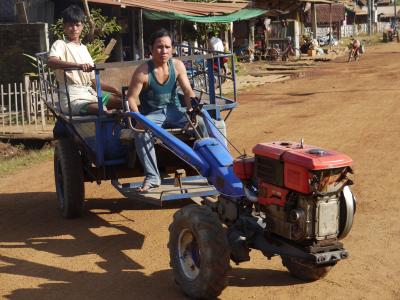
|
| Sunset over the Mekong at Don Det | Typical transport in Laos |
I liked Laos; life is still simple there compared to its neighbors, even though some places sold out to tourism to get some of those euros and dollars no matter what it does to their cities. And I did not see any US chain store in Laos at all; no KFC, no McDonalds, no 7-Eleven, and no Starbucks. What a relief.
The next morning, I rented a tuk-tuk for the day and went out to Angkor, the old Khmer temples. I focused on temples that I had missed on my previous visit in 2006. The circular temple in the northeast in the middle of a pool, surrounded by four smaller pools, was dry in 2006 but now the pools were filled, turning a dusty ruin into an enchanted place. I visited several more remote temples and wandered their extensive mazes of corridors and halls. Some had collapsed but most were restored. I was amazed that there were almost no other tourists, I even got my ticket without waiting at all.
Of course I also briefly visited the three most famous temples of Angkor: Ta Prohm, the Bayon, and Angkor Wat. Ta Prohm was my favorite in 2006: dark buildings, some collapsed, rising from the forest, mysterious, serene, and majestic. Huge tree roots were gripping the temples like alien tentacles, as if nature was clawing back what was once a jungle. It doesn't just look like a Tombraider set, it was a Tombraider set. But Lara Croft won't return. Ta Prohm was tamed and had its mystery and atmosphere squeezed out. Most exterior rubble and low vegetation was cleared away, leaving the temples standing naked, and wooden walkways were built including roped-off platforms right in front of scenic spots for the tourists to stand on and have their picture taken. They are even building a new concrete Naga passage to the temple. Morons. I guess it looked good on paper.

| 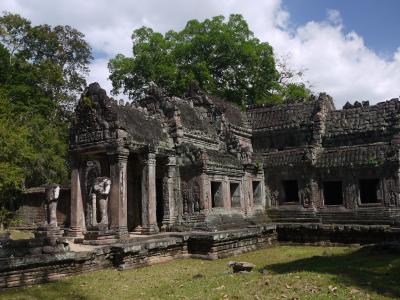
|
| Temples of Angkor | |
The Bayon with its many towers adorned with huge sculpted Buddha faces facing in four directions, and its maze of dark passages underneath, is still what it was in 2006. It has to be explored to be appreciated, from a distance it looks like a mound of rubble but it's fantastic inside and justly famous.
The central complex, Angkor Wat, was the only temple filled with tourists and tour groups, but it was being renovated and the central temple pyramid was closed. Not much to see there and no views anymore. It was magic in 2006. If there was no Unesco to recognize places like Angkor, they'd have to set one up just for Angkor to give it its dues.
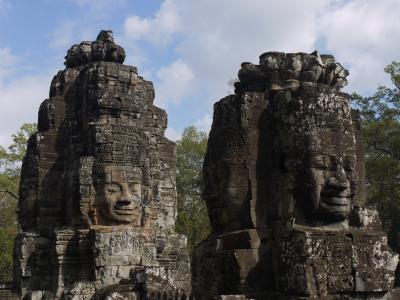
| 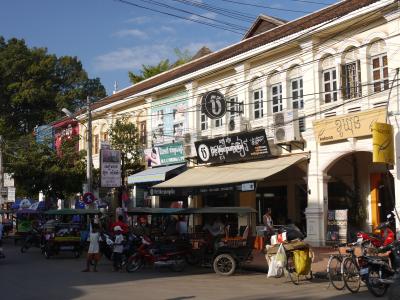
|
| The Bayon at Angkor | Old market in Siem Reap |
Siem Reap is where everyone is heading for hotels and restaurants. On my last visit, Siem Reap's Old Market district was just a dirt road lined with old French facades. Now it's paved, reducing its former small-town charm somewhat but they managed to give the place a pleasant hipness that can stand up to any western standard. It doesn't have much to do with Cambodian culture though. Touts offer massages, girls, boys, marijuana, and other pleasures for those so inclined. I had an excellent fish amok instead (a Cambodian fish curry served in a coconut shell). There is no ice cream in Laos, but there is in Cambodia, and the Khmer fruit and Khmer spices flavors were excellent.
A travel day in a long parade of buses. First a minibus to the Old Market bus stop in Siem Reap, then another minibus around the block to the VIP bus stop, then a big bus towards Poipet at the Thai border. Its brakes failed, and after rummaging around under the bus with very large wrenches and disassembling big chunks of metal found there, they found us yet another bus and we continued to the border. The dusty and bumpy dirt road we had used in 2006 was gone and replaced with a smooth paved freeway. Poipet is the only place in Cambodia where casinos are legal, and they are building two there, just past Cambodian immigration.
On the Thai side, another minibus brought us to the bus stop, where we were all summarily forgotten. Nobody seemed to know who goes where and in which bus, so I kept nagging everybody in uniform and got put on a minibus quickly. Thai freeways are wide and modern and we arrived in Bangkok quickly. I was dropped at a skytrain stop and found my way to the hotel I had reserved.
Friday, 4 December 2009
This is my fifth visit to Bangkok and I have done all the usual sights before, most several times (see here and here). So I decided to visit the modern parts of Bangkok, like Silom and Sukhumvit where few tourists go, to see how the city works. It's quite modern and clean, lots of malls, office towers, concrete, steel, and glass, but also trees. When I saw this part of town for the first time 11 years ago it was a howling mass of traffic and unbelievably polluted, and they were constructing an elevated skytrain system. That system was now complete and running, and it's working. The tracks and stations use about ten times as much concrete as you'd think would be necessary, but it's fast, efficient, and clean. I could no longer see blue smog rising up from the streets. The Bangkok business district has still too much traffic and is certainly not beautiful, but it has come a long way to a modern working city.
Christmas ornaments are everywhere in this Buddhist country. Huge opulent dioaramas with six-meter trees, green, blue, gold, or silver; phone booth-sized snow-covered swiss chalets, Cinderella, Disney dwarves, elks, snowmen, angels, and gingerbread houses. I asked some people about this but they were very unclear about the notion of snow. Like in Europe, all these things are just symbols for the annual shopping season. No prisoners taken.

| 
|
| Christmas ornaments in Bangkok | Electric monks |
Pantip Plaza is a six-floor department store packed with electronic shops. It's like Tokyo's Akihabara district packed into a single very large building. Shabbier of course, and not as cutting-edge, but it's a lot of fun. And there are no orange-robed Buddhist monks browsing around in Akihabara. I also had the pleasure of meeting another Bangkok institution, the Common Gem Scammer. He walked up to me and gave an impeccable textbook presentation, well-dressed and polite (check), has a brother in Frankfurt (check), the place I am going to is closed today (check), please follow me (check) - but here I excused myself because the next stage of the script is fun but time-consuming. It involves following him to his uncle's one-time government gem auction where I can buy expensive worthless pieces of glass that I am supposed to be able to sell for twice that price at home. Right. I decide to spend the money on a fresh fish with Thai spices at the excellent Baan Khanita restaurant instead.
Saturday, 5 December 2009
Wat Saket, the Golden Mount, is a steep and tall artificial hill north of the old town, with whitewashed staircases all the way up and a golden Chedi on top. A procession of monks in bright orange robes were marching up, beating a gong and chatting for a while, and then back down. The views from the top is great. People are praying, and there is a souvenir shop too. At the foot of the hill is a modern wat with a huge golden sitting Buddha. On the way there I was once again stalked by a nice guy who is a professional (check), has a brother in Frankfurt (check), Wat Saket is closed today (check) - and then he turned and left without another word.
I walked to the old downtown, where the palace is. There are no skytrains here, no massive structure like that could be built there. I used a river taxi on the Chao Praya instead. The city is unusually quiet, and there were colorful military parades, because this is king Bhumibol's birthday and the king is highly revered in Thailand. At night they had massive fireworks.
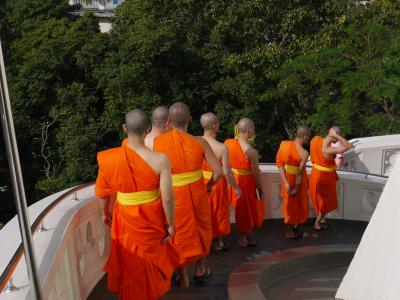
| 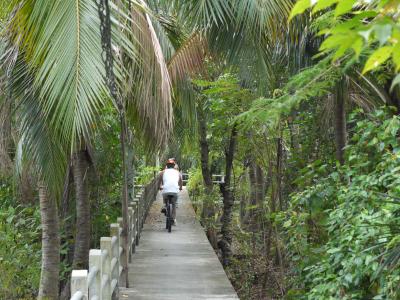
|
| Monks at Wat Saket | Bicycling in the Bangkok Jungle |
I had booked a bicycle tour with Spice Roads to the Bangkok Jungle, Bang Kra Jao. That's part of a peninsula formed by a loop of the Chao Praya, connected to the city only by a narrow land bridge. It's quite large, and even though it's very close to Bangkok's Sukhumvit business district, it's undeveloped. There are two short narrow roads, and a maze of narrow raised concrete walkways through dense forests and rice fields. There are a few small farm houses and a very small wat. Unbelievable that such a peaceful place can exist so close to the center of Bangkok. For once, I had a good well-maintained bicycle with the correct size, and a helmet. Very nice ride.
I have deleted my flickr albums because I no longer trust US cloud services.
If you liked this report and would like to read my exotic travel guide, click here.